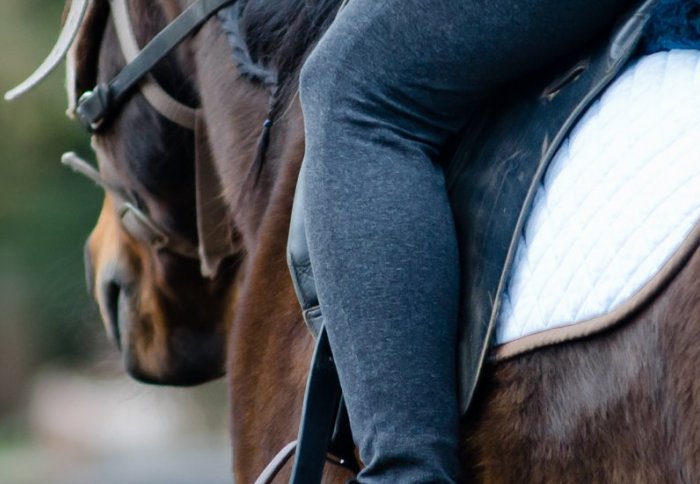
A prototype device developed by researchers gives more control the to rider

Scientists have volunteered their time to develop a device that has enabled a person with disabilities to ride a horse on his own for the first time.
One of the great advances we are currently experiencing is being able to develop devices that cost a fraction of the price to make.
– Professor Etienne Burdet
Department of Bioengineering at Imperial College London
Horse riding is a form of therapy known to have positive effects on the physical and mental abilities of riders who have disabilities. It is widely used in occupational therapy in the deaf and blind communities. Currently, there are technologies on the market that enable people living with disabilities to ride a horse unaided. However, these cost tens of thousands of pounds, taking them out of the reach of most people. Usually, riders are assisted by volunteers who guide them around.
Now researchers have donated their time to develop a prototype sensor from off-the-shelf parts that has enabled horse enthusiast Richard Brumby, who is deaf and blind with the autism spectrum disorder Asperger’s Syndrome, to ride unaided for the first time. An important feature about the technology is that it is simple and inexpensive to make, only costing the team £40. While the research is still at an early stage, the team say the technology demonstrates how assistive devices can be made more affordable for people.
Watch how the device improves Richard Brumby's horse riding experience in the video.
The device was developed by a PhD student and researchers from Imperial College London in conjunction with engineers from the Shadow Robot Company and a volunteer from the charity Riding for the Disabled.
The technology consists of a small console the size of a wallet, which is wirelessly connected to an App on a mobile phone. The console is worn by the rider around their waist. It is connected by wires to two straps, which wrap around each of the rider’s arms.
The device works when a volunteer on the ground wirelessly sends directions to Brumby via the phone to the console. It relays the commands as vibrations to the straps in the arm so that Richard can steer the horse. For example, a vibration on the right strap would indicate that Richard needs to pull the reins to the right or vibrations on both straps would indicate to pull both reins backwards to stop the horse. The vibrating instructions are designed to be easy for Richard to learn and memorise, and they do not distract him while navigating on the horse.
Professor Etienne Burdet, who is Imperial’s lead from the Department of Bioengineering, said: “One of the great advances we are currently experiencing is being able to develop devices that cost a fraction of the price to make. This opens the door to a greater range of technologies being more affordable and accessible to people, especially those living with disabilities. This project really demonstrates how we can donate our time and work together collectively in the community to empower others to be more independent. We are a long way from rolling this affordable technology out to disabled riders across the UK, but we’ve demonstrated that it is feasible.”
The collaboration began when Doug Smith, a former mounted policemen and volunteer for Riding for the Disabled, approached Rich Walker, the Director of Shadow Robots with a challenge. Smith wanted to find a way to make riding more enjoyable and interactive for his protégé Richard, who until then had little control of the horse, being led around a paddock by two volunteers.
“Unlocking the connection between riders and horses is key to our work,” said Smith. “This collaboration means that we have a new way of doing just that – helping Richard to build his confidence and skills, which was unimaginable in the past.”
The next step in the project saw Walker approaching Dr Burdet and Dr Ildar Farkhatdinov from the Department of Bioengineering at Imperial. Together they devised a project for Matjaz Ogrinc, who is a PhD student at the College at the time and developed the simple easy-to-use sensor technology using readily available parts.
Ogrinc said: “When you start a PhD in robotics you don’t know where it might end up and that is part of the joy of doing research, but I never dreamed that I would be able to help to improve the life of someone through my work. It is only early days, but this prototype technology shows promise.”
For the past three months the device has been used by Smith to guide Brumby during his riding lessons. Richard also used the technology at riding events to demonstrate the effectiveness to the deaf and blind riding community.
The next steps will see the Imperial team carrying out user evaluation studies, publishing their research on the technology and investigating further opportunities for developing new applications for the device in areas such as Paralympic sports.
Article text (excluding photos or graphics) available under an Attribution-NonCommercial-ShareAlike Creative Commons license.
Photos and graphics subject to third party copyright used with permission or © Imperial College London.
Reporter
Colin Smith
Communications and Public Affairs

Contact details
Email: press.office@imperial.ac.uk
Show all stories by this author
Leave a comment
Your comment may be published, displaying your name as you provide it, unless you request otherwise. Your contact details will never be published.





Comments
Comments are loading...